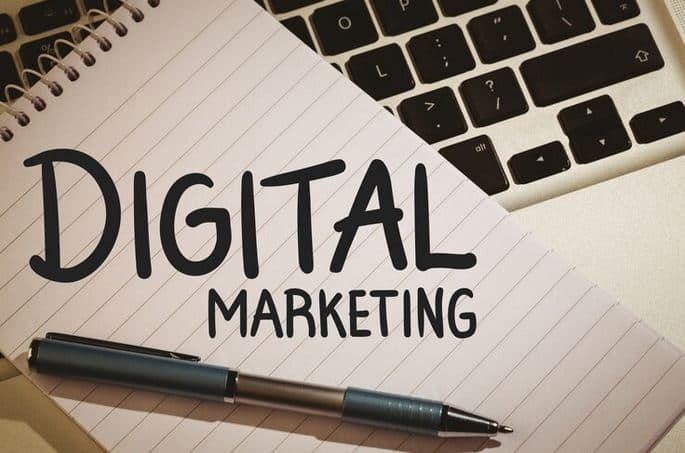
Do you ever feel lost trying to keep up with marketing in a fast-moving online world?
As the web gets more connected, understanding digital marketing theories is vital. This is because they help you reach potential buyers more effectively and grow your business.
This guide explains 15 game-changing online marketing theories and concepts. Whether you’re starting a new business or looking to scale an existing one, they will help you understand:
-
What motivates people to click and buy online
-
The optimal use of various digital marketing channels
-
Creative ways to engage tech-savvy audiences
Master the essential digital marketing theories in this guide, and you will:
-
Increase website visitors
-
Run more productive campaigns
-
Build trust and tailor smooth experiences
-
And sell more of your products and services
It’s time to ditch guesses and use smart marketing approaches!
Understanding Digital Marketing Theories
What are digital marketing theories, and why do they matter?
Digital marketing theories help explain how consumers behave online and ways to effectively reach and engage them. They provide tested models to guide marketing plans using digital tools and platforms. Their purpose is to achieve branding and sales goals.
Some key points:
-
They adapt traditional marketing theories, such as Maslow’s hierarchy of needs and SWOT analysis for online channels.
-
Digital marketing theories spotlight opportunities for marketers. They provide ways to better connect based on user preferences.
-
They supply strategic frameworks. These can form decisions around content, targeting, budget allocation, etc.
-
They still need testing. Digital marketers must try the ideas with real campaigns. This checks if they work for a unique business situation before expanding use.
These theories provide marketers with proven best practices customized for the digital space. They allow brands to engage wired-in buyers and drive growth.
The importance of digital marketing theories keeps growing. As consumers spend more time interacting online, the landscape expands. So, understanding models that tap into user motivations and path-to-purchase is vital. Let’s discuss 15 of them below.
#1. Content Marketing
Content marketing means creating and sharing valuable online material to attract and keep buyers. The focus is on informing, educating, and entertaining instead of always directly selling.
-
Content builds awareness and trust for brands.
-
It aims to provide solutions for an audience to gain their attention and loyalty.
Content comes formatted as:
-
Blog articles and posts
-
Ebooks and guides
-
Webinars and videos
-
Podcasts
-
Infographics
-
Quizzes and polls
-
Email newsletters
Strategic Content Drives Revenue
Relevant content brings in website visitors from search engines and social referrals. More traffic, in turn, lifts sales.
Useful blogs encourage subscriptions and social media follows. They nurture the relationship with a consumer beyond purchases.
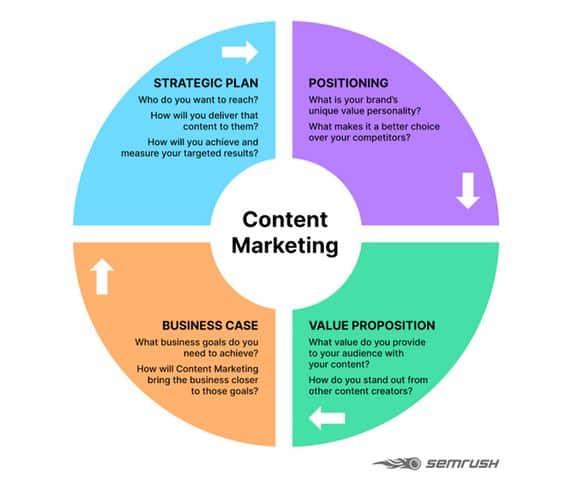
Source: Semrush.com
#2. Search Engine Optimization (SEO)
SEO stands for Search Engine Optimization. It means optimizing online content and sites to rank higher in search engines like Google and Bing.
When people search keywords related to your business, SEO helps them find and click on your site faster. So you get free website visitors from search without paying.
Top search visibility is vital for:
- Driving more leads and sales
- Establishing expertise so customers view you as credible
- Beating the competition – according to Monster Statistics, 70% of searchers click on websites in the top 5 results on Google
Better rankings also compound over time as more people visit, stay, link, and share your pages. Positive feedback loops kick in to stay on top.
SEO remains among the most cost-effective strategies for long-term revenue generation. Adjusting and improving site content and coding for search spiders leads is cheap but hugely rewarding.
Common SEO Practices
- Keyword research to pick terms buyers use
- Adding keywords naturally to page text
- Optimizing site speed by minimizing files
- Easy mobile site navigation
- Getting credible sites to link back
- Tagging media for search bots to “see”
- Tracking rankings and click performance
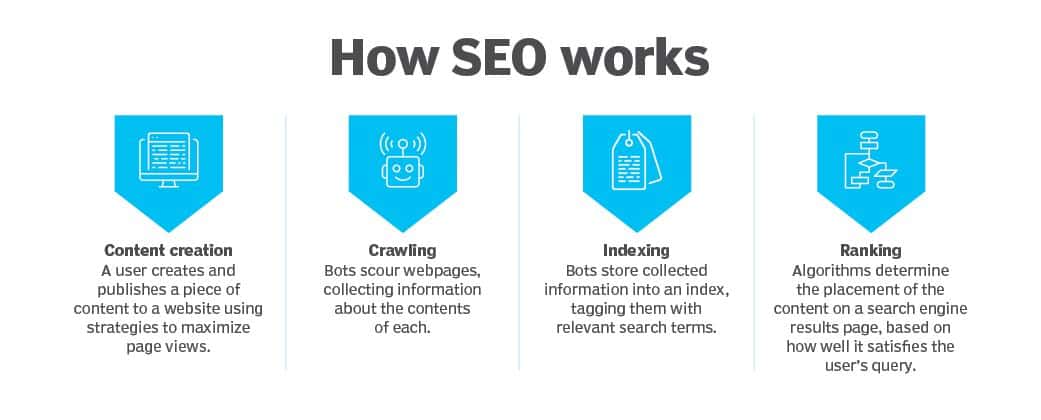
Source: techtarget.com
#3. Search Engine Marketing (SEM)
SEM means Search Engine Marketing. It refers to paid advertising on search engines, websites, and content networks.
The most popular SEM platform is Google Ads, where companies bid on keywords. When users search those words, your ads display beside or above the results. You pay only when people click your ad.
Benefits of SEM
-
Instant visibility – ads show on the first page minutes after setting up campaigns
-
Increase website traffic quickly by essentially “buying” visits
-
Laser-focus SEM campaigns on buyer keywords and interests
-
Track clicks and conversion rates accurately to calculate the return
-
Display ads across platforms like YouTube based on the audience
-
Expand reach rapidly across the world or niche geo-targets
Unlike SEO, SEM delivers immediate results. But it requires ongoing budgets for ads and specialists. Treat SEM as a calculated investment with revenue goals and tracking rather than a cost center.
Maximizing ROI
-
Research and bid on high commercial intent keywords
-
Test ad variations for best click-through rates
-
Show the best landing pages that convince visitors to convert
-
Set targets, monitor stats, adjust bids, and copy per performance
SEM and SEO work hand in hand. SEO keeps visitors coming long after you pause your ads. SEM buys customers that eventually also find you via SEO.
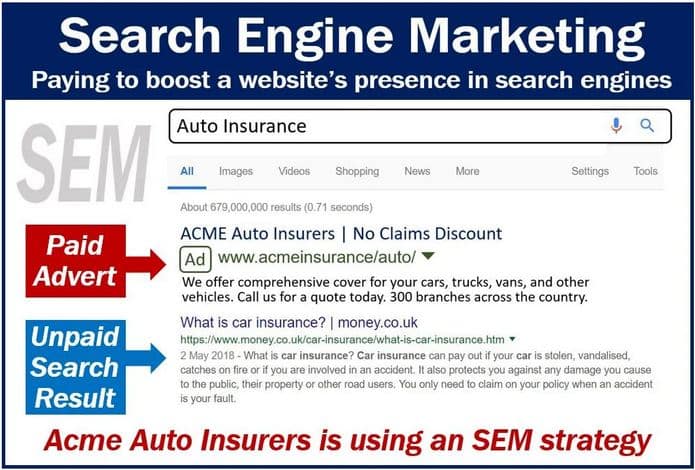
Source: marketbusinessnews.com
#4. Social Media Marketing
Social media marketing means promoting your business on popular social sites like Facebook, Instagram, X, TikTok, YouTube, etc.
When used rightly, it can:
- Spread awareness about your marketing campaign or company
- Help people see your brand positively
- Engage potential buyers
- Drive sales
Benefits of Social Media Marketing
- Reach large communities for free
- Chat and share content to build relationships
- Encourage word-of-mouth referrals
- Show expertise with valuable posts
- Quickly get feedback to improve
- Target messages using user data
- Foster loyal followers
- Support other marketing efforts like emails and ads
Make sure social content matches what buyers want and need to grow sales. Track when they click your site, sign up, and purchase.
Best Practices for Social Media Marketing
- Post engaging photos/videos regularly
- Respond quickly to increase engagement
- Promote discounts, webinars
- Run contests and optimize ads
- Join industry conversations
- Review analytics to do more of what works
The social effect of this form of marketing multiplies exposure. And followers drive site traffic better than cold paid ads. Sustained value comes from building relationships and community.
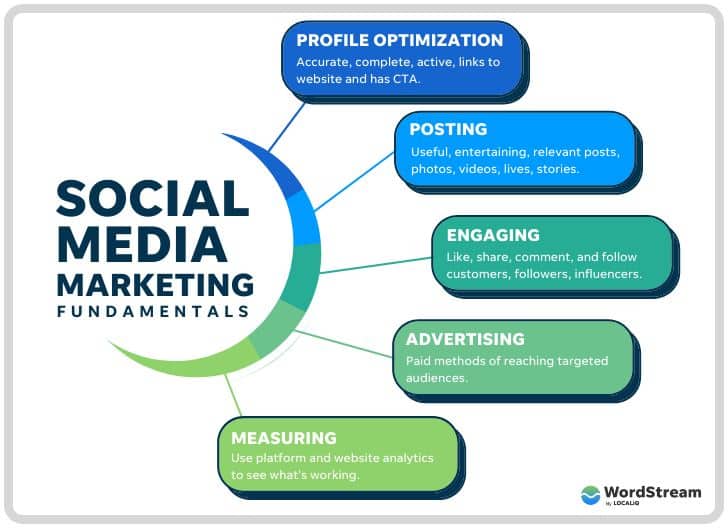
Source: wordstream.com
#5. Email Marketing
Email marketing means sending messages and offers to people who signed up to receive your newsletters. It helps drive repeat sales from past customers cost-effectively. It also nurtures prospective customers over time.
Benefits of Email Marketing
-
It’s a low-cost way to establish communication and engage an interested audience
-
High return – $44 for every $1 spent if done well, according to CampaignMonitor
-
Communicate offers quickly, like flash sales
-
Drive to social media, the website, phone orders
-
Reach users directly without algorithms or ads
-
Automate personalized content matched to interests
-
Split test subject lines, design for optimization
-
Easy measurement of open, click-through rates
Strategy Tips
-
Offer an appealing and valuable lead magnet. Visitors will give their emails to download free resources.
-
Segment users based on past purchases and behavior
-
Promote the most relevant products to targeted groups
-
Find ideal email frequency through testing
-
Drive time-sensitive purchases with alerts
With careful planning, email can help you sustain visibility between marketing campaigns.
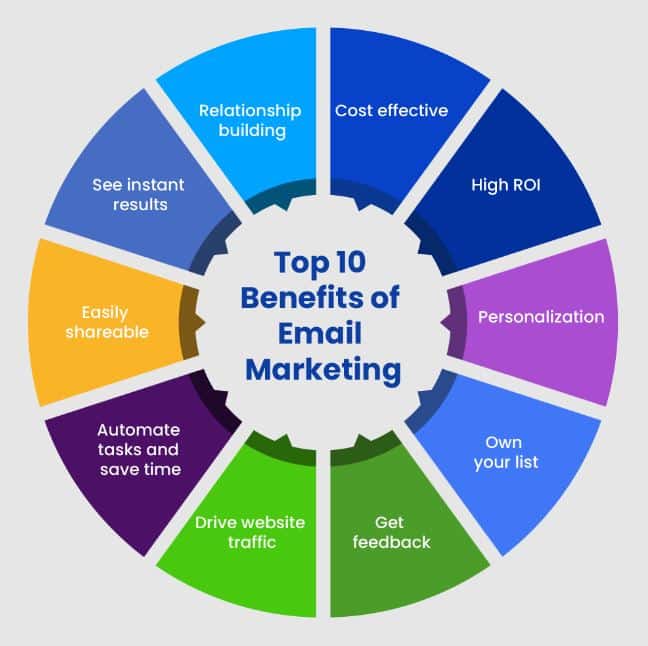
Source: aweber.com
#6. AIDA Model
AIDA stands for:
- Attention
- Interest
- Desire
- Action
It’s an acronym for the four stages of getting people to buy something. The AIDA model helps shape a journey that turns strangers into paying customers.
This concept has guided marketing and sales for over a century before the digital era. But it remains highly relevant even as platforms and technology evolve.
Why It Matters
Mapping a logical AIDA path to revenue prevents disjointed digital activities that confuse instead of convert.
- Attract eyeballs with valuable content as bait
- Capture interest by resonating with needs
- Amplify desire by positioning your solution
- Facilitate action by making it easy to buy
AIDA-aligned messaging across channels like email, social, search ads, and web pages. The aligned messaging drives higher ROI on marketing budgets.
Always view marketing through the AIDA lens, whether launching a new e-commerce site or promoting a discount. Use it to sequence digital efforts for traction and growth.
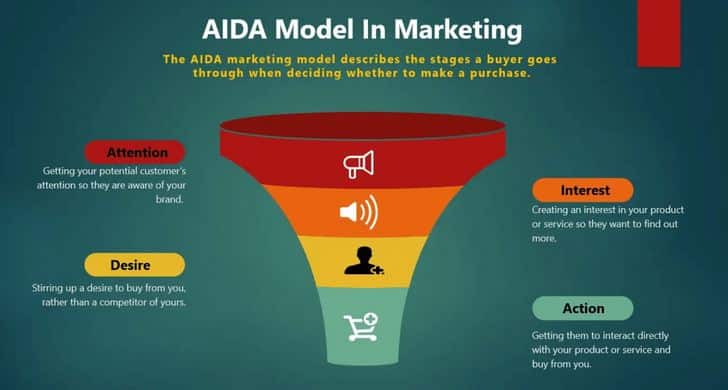
Source: linkedin.com
#7. Conversion Rate Optimization (CRO)
Conversion rate optimization (CRO) means boosting the percentage of your website visitors who convert into customers. The goal is to get more people to take desired actions like:
-
Signing up
-
Downloading content
-
Clicking links
-
Making a purchase
Higher conversion rates directly increase revenue. If 1% more visitors buy due to better on-site UX, faster load speeds, etc, scale effects are massive.
Best Practices for CRO
-
Obsess over customer experience and friction points
-
Shorten forms by removing unnecessary fields
-
Use trust factors like testimonials and security seals
-
Simplify navigation so people find info quickly
-
Make prominent, benefit-driven calls to action
-
Personalize content based on visitor persona
Keep testing page layouts, copy, visuals, and flows using data. Monitor marketing metrics to double down on what converts.
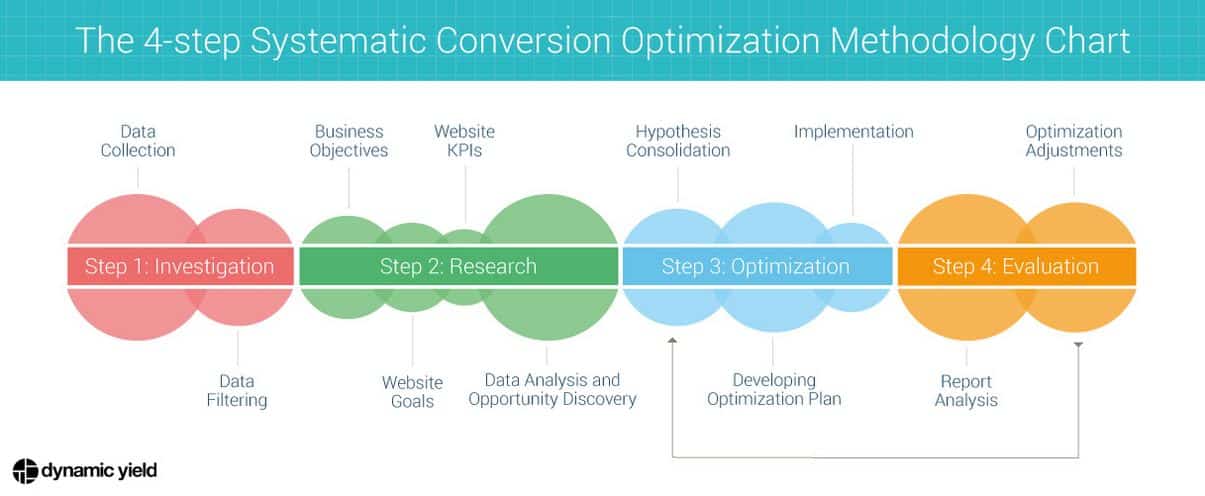
Source: dynamicyield.com
#8. Customer Relationship Management (CRM)
CRM stands for Customer Relationship Management. It refers to the tools and tactics you can use to boost sales by better understanding each customer.
The goal is to enhance the satisfaction and loyalty of high-value buyers so they:
-
Spend more over time
-
Refer friends and colleagues
-
Give more feedback to improve
Benefits of CRM
-
360-degree customer view from one dashboard
-
Track behavioral trends and purchase history
-
Automate personalized promotions across channels
-
Route leads faster to reps based on past convos
-
Enable self-service account management
Effective CRM directly grows revenue by:
-
Identifying upsell opportunities earlier
-
Reducing customer churn year-over-year
-
Lowering acquisition costs through referrals
-
Strengthening retention via tailored experiences
Invest in integrations, data hygiene, and CRM adoption across teams. That will help to maximize customer lifetime value.
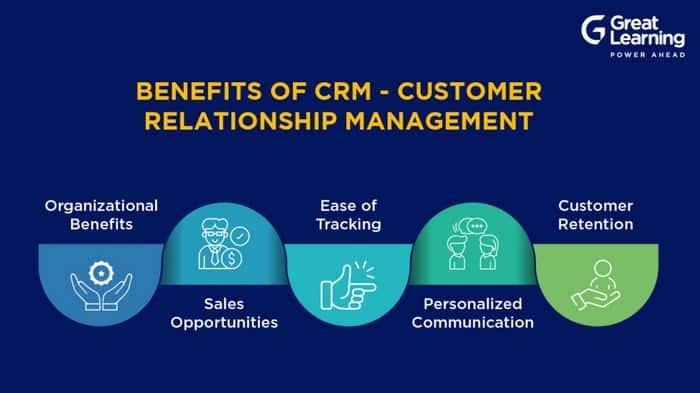
Source: mygreatlearning.com
#9. Social Proof
Social proof means people follow what others do, say, or approve to guide their decisions. Seeing something as popular makes it seem “validated.” We assume if many believe it, we can too.
Social proof builds trust in products, services, and companies. In uncertain times, we lean on what the crowd believes through:
- Customer reviews and testimonials
- Expert endorsements and media features
- Celebrity partnerships and sponsorships
- User-generated content like social shares
Digital Marketing Use Cases
Social proof lends credibility that sways customers online to:
- Click on search results
- Purchase a positively reviewed item
- Spread branded posts wider through shares and tags
- Refer friends after enjoying the product experience
So showcase proof points like:
- App store ratings and download numbers
- Video testimonials and customer stories
- Social followers and community engagement
- Industry recognitions, press releases (PR), and award badges
Flaunting social signals indicates confidence while easing visitor doubts. But authenticity matters most – fake tactics backfire over time.
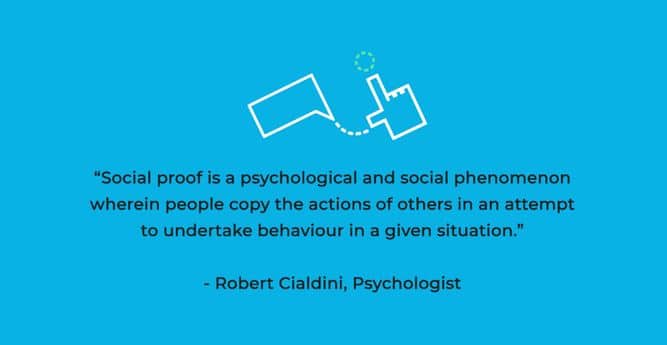
Source: contentlabs.co.uk
#10. Marketing Automation
Marketing automation refers to software tools that automate repetitive marketing tasks. The goal is to save time while improving results.
Benefits of Marketing Automation
- Identify and score leads based on activity
- Trigger personalized emails when prospects pass milestones
- Route-ready leads to sales reps automatically
- Create customer segments and targeted campaigns
- Post social messages using optimal keywords
- Show remarketing ads automatically after site visits
- Simplify complex workflows across teams and tools
Well-set-up automation aligns with the buyer journey to:
- Capture more leads with less work
- Convert higher percentages of leads faster
- Make every channel and touch intelligent
- Gain time to focus on strategy vs manual tasks
- Scale your revenue operations without expanding headcount
Embrace marketing technology if you want to grow your business. Let software handle the heavy lifting while you think about the bigger picture. When you pair automation with a CRM, it compounds returns over time.
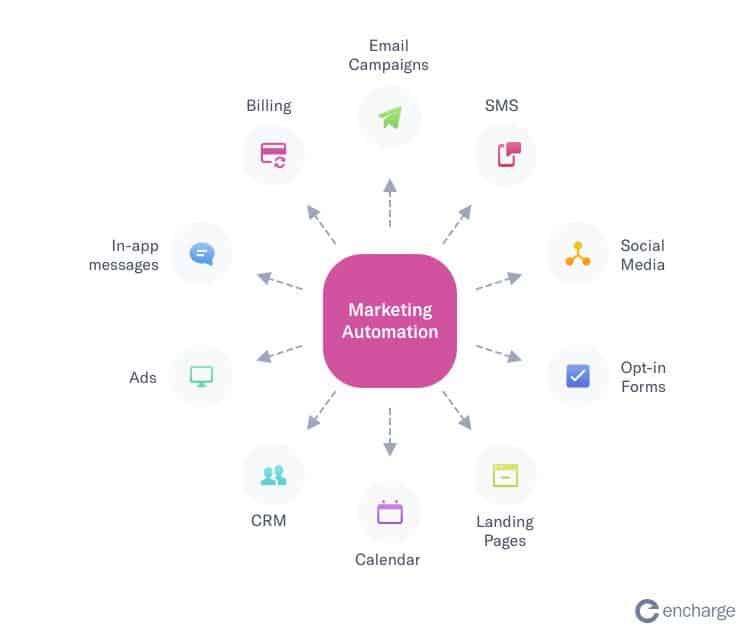
Source: encharge.io
#11. Data-Driven Marketing Strategy
A data-driven strategy uses metrics, analytics, and insights to guide marketing decisions.
It takes the guesswork out of complex choices like:
- Which segments should we target?
- What marketing platforms and features drive ROI?
- How much budget to allocate per channel?
- What content types boost engagement?
- When should you post on social media for the most clicks?
Benefits of Data Reliance
- Quantify assumptions about customers
- Track meaningful key performance indicators (KPIs)
- Identify bad marketing ideas faster before overspending
- Optimize budgets, teams, and tech stacks
- Automate personalized experiences
- Spot trends to capitalize on or problems to fix
Embed data tracking and analysis tools into platforms from day one. Let numbers direct strategy, not just validate direction. Build a culture and process that uses metrics to align activities with revenue and growth opportunities.
Without data, digital marketing efforts risk wasting money. Measure results consistently to refine for impact.
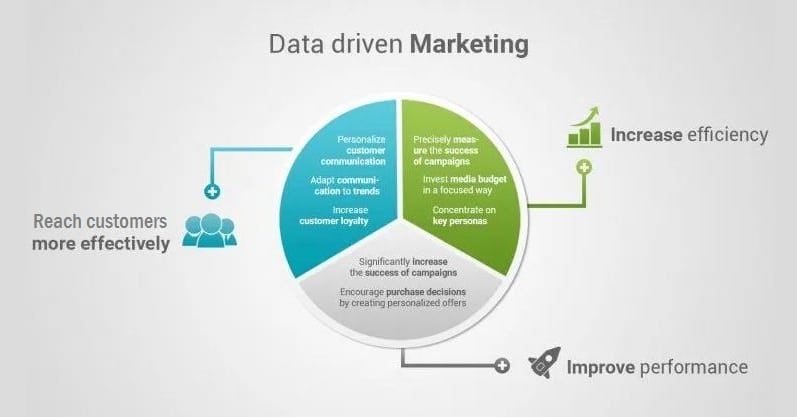
Source: datafloq.com
#12. Mobile Marketing
Mobile marketing is about reaching people on their phones and tablets. The usage of mobile devices is growing. So, ensuring sites and ads display cleanly on small screens is key for engagement and revenue.
-
Over 58% of global website traffic is from mobile according to Statista.
-
SearchEngineJournal reports that mobile drives over 50% of online purchases in many countries
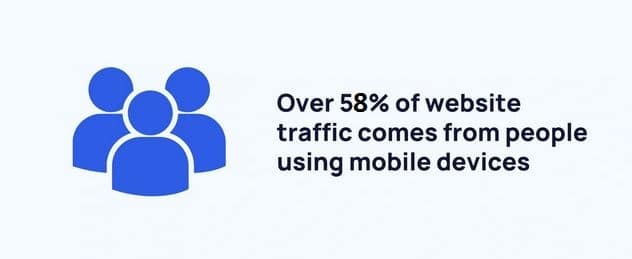
Source: explodingtopics.com
Mobile Marketing Best Practices
-
Streamline site navigation for handheld ease
-
Resize visual assets for quick loading
-
Minimize typing needed through UI
-
Integrate Apple/Google sign-in and biometrics
-
Use click-to-call, geo-fencing, and QR codes
-
Test different ad formats per platform
-
Avoid intrusive pop-ups that frustrate
Mobile fits into a marketing plan that uses many channels. They also allow large-scale custom offers – things that directly raise sales.
So, optimize for mobile devices to connect with audiences wherever they go. Revenue and retention soar when they drive the customer experience.
#13. Customer Lifetime Value (CLV)
Customer Lifetime Value is how much a buyer will spend with your brand over time.
It factors their:
-
Average purchase value
-
Purchase frequency
-
Loyalty duration
Loyal, recurring customers have a high lifetime value. They contribute to long-term profits vs one-off buyers.
Why the CLV Theory Matters
-
CLV shapes spending to acquire customers.
-
It gauges if marketing investments will pay off over the years.
-
CLV helps retain and reward the best patrons.
Key CLV Strategies
-
Email nurture campaigns to sustain interest
-
Loyalty programs with personalized rewards
-
Special access, sales, and support for VIPs
-
Automate follow-ups for reviews and referrals
Knowing and using this metric ensure budgets chase buyers with the best return potential. Keeping customers in the long run brings in more money than one-time sales.
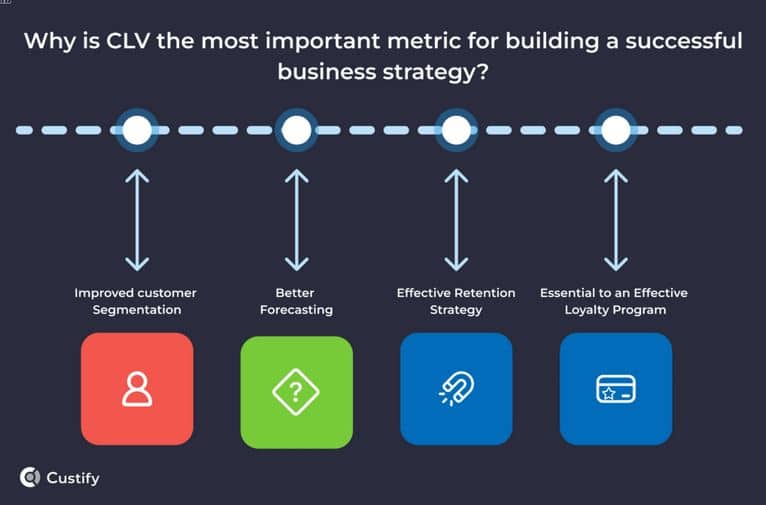
Source: custify.com
#14. A/B Testing
A/B testing means using two different versions of something to see which performs better.
In marketing, brands test elements like:
-
Email subject lines
-
Website headlines
-
Layouts
-
Sign-up forms
-
Social ad images
They measure actions like opens, clicks, registrations, and sales. The aim is to learn what customers prefer.
Benefits of A/B Testing
-
Remove opinions and assumptions
-
Find quick fixes to lift results
-
Confirm ideas that have the biggest impact
-
Reduce guesswork around optimization
-
Back decisions with data that gets attention
Testing different combinations allows continual improvement without risking all traffic to one option. Over time, slight tweaks compound major revenue gains.
Bake A/B experiments into your marketing digital channels using dedicated tools. Turn ideas into insights to better attract, engage, and convert more visitors.
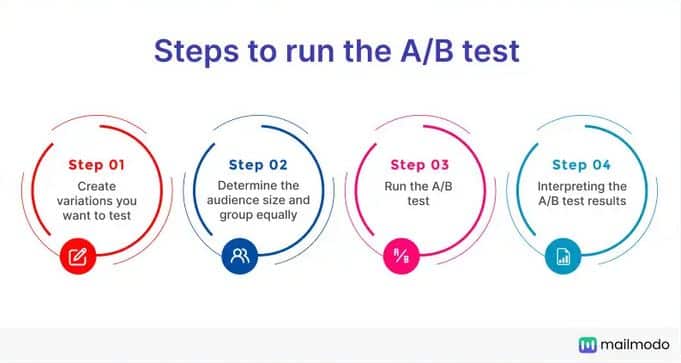
Source: mailmodo.com
#15. Segmentation and Personalization in Online Marketing
Segmentation means splitting up customers or potential customers into groups that share things like:
- Age and life stage
- Location and why they buy
- Past purchases
With tighter segmentation, your messages can get more personalized and on-point. Targeting niche groups sells better than spraying the same message everywhere.
Why It Helps
Sending wide content to every customer lacks relevance, wastes budget, and creates clutter.
Segmenting allows:
- Social proof when people see peers interested
- Promote timing matched to a group
- Showcase benefits that appeal specifically
For example:
- Students want scholarships
- Parents care about family safety
- Millennials influence each other
- Big companies want scalability
Tailor your content, deals, and site experience to each segment. As the market segmentation gets more precise, you can fine-tune engagement strategy.
Personalization keeps users engaged, improves performance, and grows revenue over time.
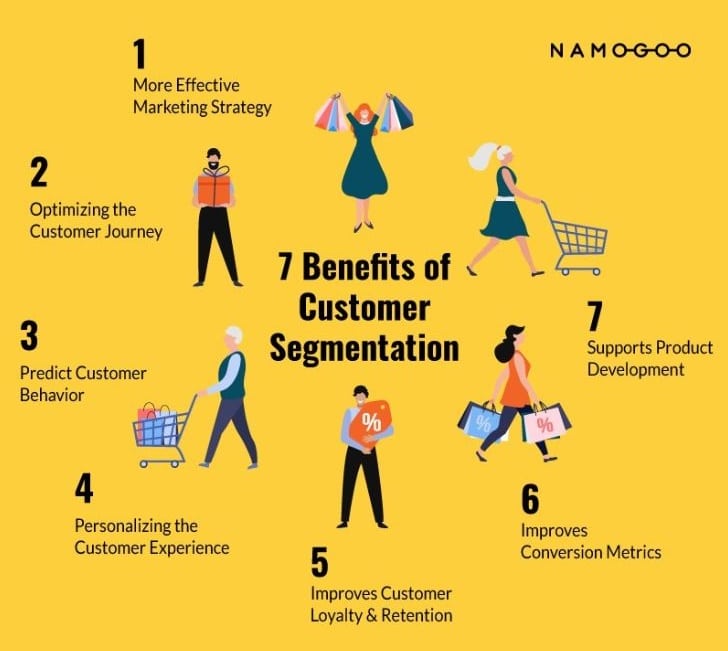
Source: namogoo.com
Conclusion
The 15 digital marketing theories and models we’ve covered form a toolset for revenue growth. Each theory provides an essential piece.
Use these theories and models to attract customers, build loyalty, and grow your business.
First, grasp the core principles instead of temporary fads. And then use evidence-based approaches to guide your marketing strategy. You must map an ideal path to guide visitors into happy repeat customers that grow your business revenue.
Want to grow your business revenue by leveraging paid targeted social media advertising?
Then partner with us at AdvertiseMint.
We are experts at using powerful advertising technology to grow the revenue of businesses like yours.
We will showcase your products or services to thousands of targeted potential customers. That’s if you are eager to take your business to the next level.
You should give it a shot!
Click here to request your FREE Facebook ads consultation now!
